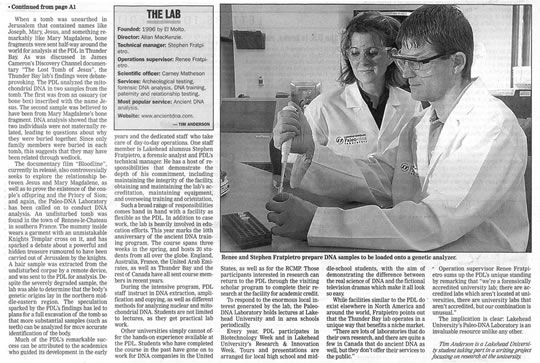(December 16, 2009 – Thunder Bay, ON) Dr. Carney Matheson, Scientific Officer of the Lakehead University Paleo-DNA Laboratory as well as Anthropology Professor at Lakehead, is involved in another investigation of ancient DNA that could have significant implications. Dr. Matheson co-authored a new research paper that has just been published in PLoS ONE, a scientific journal published by the Public Library of Science. The paper presents scientific research conducted on “The Tomb of the Shroud,” – a tomb found in Jerusalem dating back to the time of Jesus.
This rock-hewn burial cave, originally discovered by an archaeological team led by Shimon Gibson, Boaz Zissu, and James Tabor, belongs to a cemetery known as Akeldama or “Field of Blood,” as described in the Bible (cf. Matthew 27:3-8; Acts 1:19), and located in the lower Hinnom Valley in Jerusalem. In comparison to more than 70 other tombs in the Akeldama area, this particular tomb is unique as it contains remnants of a burial shroud and evidence of leprosy (Hansen’s disease) and tuberculosis in the shrouded male remains within it. This is the oldest known case of leprosy with confirmed dates and molecular evidence. Some of the other individuals in this multi-chambered tomb showed signs of tuberculosis, and ancient human DNA was detected to piece together the family relationships.
The molecular investigation of the first century shrouded man was led by Professor Charles Greenblatt of the Hebrew University, first conducted at the Hebrew University’s Kuvin Centre for Tropical and Infectious Disease and later replicated at Lakehead University’s Paleo-DNA Laboratory. Additional work was conducted by Helen Donoghue at the London -based University College’s Centre for Infectious Diseases and International Health.....continued....
Remarkably, no other first century tomb from Jerusalem had hitherto been examined by molecular methods. “The discovery of the presence of M. tuberculosis and M. leprae in the individuals buried within the "Tomb of the Shroud" is significant in understanding the geographical and temporal distribution of tuberculosis and leprosy in antiquity,” explains Dr. Matheson. “This research is evidence that molecular pathology clearly adds a new dimension to the archaeological exploration of disease in ancient times, and it showcases the world-class forensic work on ancient human DNA undertaken at Lakehead's Paleo-DNA laboratory.”
The successful genetic analysis of unique archaeological sites such as "Tomb of the Shroud" poses great promise for future investigations into host-pathogen relationships and evolution, geographic distribution, and epidemiology of disease and social health in antiquity.
Click here to read the research paper in full.


